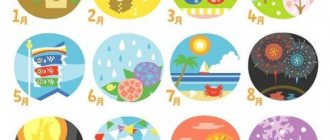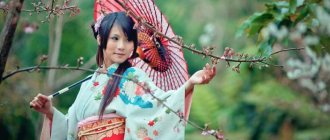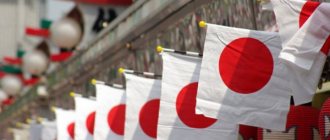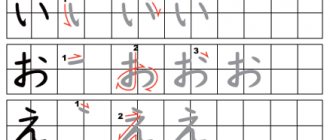Girls' Day in Japan originates from an ancient tradition: thousands of years ago, the Japanese used paper dolls to protect themselves and their children from illness. In ancient times, on the third day of the third moon or on the day of the serpent - March 3, it was customary to create a small “copy” of a person from improvised material, after which the following ritual was carried out: the doll was used to rub the person’s sore spots, small children were completely rubbed. At the same time, conspiracies or prayers were said, designed to transfer illness and misfortune to an artificial “copy”.
Subsequently, the doll was placed in baskets and released into flowing water or burned. It was from this ancient ritual that the girls' holiday - Hina Matsuri - emerged. Hinamatsuri is not a public holiday, but is considered one of the most beloved in the country.
The Hinamatsuri holiday represents the wish for prosperity and good health to girls.
Historical origins
Hinamatsuri, a girls' holiday in Japan, became a national celebration in the mid-18th century. The eighth shogun of the Tokugawa dynasty named Yoshimune (1677-1751) loved his daughters very much, of whom he had many. He spoiled the girls, using both court traditions and folk customs to organize entertainment.
On the first day of the snake, when ordinary people floated dolls on the water, a similar ceremony was also held in the imperial palace. There was also an exhibition of richly dressed dolls for girls. The tradition was picked up by the courtiers. And so it happened. Every third of March, a celebration was held for little girls, and dolls were always a part of it.
The people also liked this ritual. Moreover, the favorite game of little ones in simple houses was hina-asobi. Its essence was to create a married couple out of paper. The girls made utensils, houses and various household items. They got together and came up with family life events for their characters. Their parents encouraged them to do this activity. It was believed that the game prepared little beauties for marriage.
Towards the end of the Edo period, the dolls acquired the appearance and name Hina Ningyo, which is still used today.
The tradition of getting rid of illnesses through dolls has survived in some prefectures to this day. People, as in the old days, rub sore spots with dolls and send them swimming along the river.
In Kyoto Prefecture, the tradition of floating dolls in small boats down the river and praying for the safety of children continues today. Considering that this causes inconvenience to fishermen, since ceremonial dolls constantly fall into their nets, boats with dolls began to be lowered directly into the sea.
After the holiday is over, when everyone has left, the dolls are caught and taken to the temple for burning.
And at home for the girls, the parents organize a celebration. It involves completely different dolls. Since the eighth century they have changed and improved. Now they are seated on a special stepped stand - hinadana. The most honorable place is occupied by the imperial couple.
How is Hinamatsuri celebrated in Japan?
Nowadays, most families with daughters decorate their homes, usually with five-seven tiered platforms of Hina dolls. Decorating dolls begins in mid-February and is left until the end of March 3.
Traditionally, grandparents or parents of a newborn girl buy a set of Hina doll jewelry for the child's first Hinamatsuri.
Families remove decorations immediately after Hinamatsuri as superstitions claim that keeping the dolls after March 4 will result in late marriage for daughters. In some areas of Japan, people still release paper dolls into the water after the holiday, praying for health and good luck.
Hinadana
Mothers prepare the girls' party in advance. In cities they even open special fairs where you can purchase the necessary paraphernalia. This is where people communicate, share ideas, and just have fun. They buy dolls, toy furniture, outfits, and jewelry. Here you can also pick up sweets for receiving guests - this is an important part of the celebrations.
Hinadana is a stepped shelf or stand. As a rule, it has seven levels, but it can be less or more. It is covered with rich scarlet fabric. The dolls are seated according to ranking:
- Emperor and Empress;
- court ladies-in-waiting holding attributes for the sake bottling ceremony;
- musicians;
- other courtiers, samurai, children, servants, workers.
The lower level is reserved for household utensils. What's missing here:
- tiny furniture;
- fine tableware;
- mirrors;
- decorations;
- carts;
- objects of art;
- tools.
Hamaguri Ushio-jiru (clear clam soup)
Serves 4
8 small (or 4 large) clams 4-inch square kombu 3 1/4 cups cold water 3/4 teaspoons mitsuba salt parsley or cilantro for garnish lemon zest, finely grated for garnish
1. To prepare the clams: Place the clams in a large bowl and cover with heavily salted water. Let them sit in a cool, dark place for 2 to 5 hours. this helps them remove any sand or dirt that may have gotten into them. Once the clams are soaked, gently rinse the shells under cold running water.
2. To make the soup: Place clams, kombu and cold water in a medium saucepan. Place the pan over medium-high heat. Before the water boils, remove the algae. Boil the water until all the clams have opened, then season the broth with salt and skim off any scum from the surface of the water. Remove the clams, then pour the broth through a fine-mesh sieve (or 2 layers of cheesecloth) into another saucepan.
3. Serve: Place 2 clams, a sprig of mitsuba, parsley, cilantro and a pinch of lemon zest on each plate. Pour in the hot broth and serve.
Views: 2,927
Share link:
- Tweet
- Share posts on Tumblr
- Telegram
- More
- by email
- Seal
Family traditions
Japanese dolls gradually became relics. Making this holiday attribute is a great art. It has been developed and accumulated for centuries. Many families keep their own secrets of puppetry. Each toy is dressed up in traditional clothes. Faces are painted. Ladies have traditional hairstyles.
The Empress is dressed in 12 kimonos, as required for an official ceremony. The musicians have instruments in their hands. The maids of honor also hold miniature paraphernalia - miniature replicas of those used in the sake pouring ceremony.
All levels are decorated with miniature trees and lanterns. This composition honors peach flowers. The fact is that in Japan this particular tree blooms by the beginning of March. This period is called momo no sekku. Delicate pink peach petals are associated with quivering girlish youth. They are associated with meekness, grace, and calm femininity.
It is these traits that parents try to instill in their daughters, as they are the key to a happy family life. Dolls should not be left on public display for long periods of time. This is considered a bad omen. They can delay the moment of the desired marriage of the beauty for whom the girls' day is being held. They are packaged and carefully stored until next spring.
Decorations
In addition to traditional dolls, other decorations are also used during Hinamatsuri. For example, branches of peach blossoms . They can be either real or made of paper or silk.
Tsurushi-bina (つるし雛, tsurushi-bina) decorations are also an important part of Girls' Day decorations. These beautiful handmade jewelry are made of silk and thread. Using traditional good luck motifs to symbolize happiness and growing up. You can often see images of peaches, rabbits, monkeys, triangles and dolls.
Celebrations
The room in which the hinadana stands also gives a festive look. For this purpose, flower petals are used, usually artificial. They make balls out of them, tie beautiful silk ribbons to them, and hang them from the ceiling. The room should have an elegant, solemn appearance. The girlfriends of the little hostess of the holiday are invited here. The girls are treated to the sweets hishi mochi, hina arare (rice cake sprinkled with molasses), and cookies. All dishes are washed down with shirozake (sweet sake). The hostess is obliged to entertain her girlfriends. All together they admire the dolls and discuss their merits.
Delicious holiday
Apart from decorating the floats with gorgeous dolls, the Japanese also celebrate the day by preparing special foods and drinks.
First of all, a common drink for everyone (including children) is shirozake (白酒). It consists of sweet sake that contains enough alcohol (nine percent) to make parents wince.
However, traditional dishes are more colorful and child-friendly.
Hina arare
Arare (reられ) is a rice cracker named after hail or snow pellets. Typically, hina arare are colorful and flavored with soy sauce or sugar, depending on the region.
Hishi mochi
Another sweet delicacy is Hishi mochi (菱餅), a multi-layer rice cake, with flowers of red (pink), white and green. In some areas of Japan, the color red is replaced by yellow, and there may be five or seven layers of mochi instead of three.
In the Edo era, the sweet diamond was believed to symbolize fertility.
Chirashizushi
If you prefer something savory, Chirashizushi (ちらし寿司) is a rice dish seasoned with vinegar, sugar and a pinch of salt, topped with assorted sashimi and a variety of other ingredients that form different layers of beautiful and vibrant colors.
Ushiojiru
Finally, Ushiojiru (潮汁) is a clear broth-based soup containing "hard shellfish" as the main ingredient. The shells symbolize the unity and peacefulness of the couple, since only two perfectly symmetrical double shells can fit tightly together.
The only real prep work that needs to be done is soaking the clams in salt water for a few hours to help them get rid of the sand and dirt (sand clams are NOT tasty). One of the keys to a delicious broth is skimming off the scum that collects on the top of the water (trust me, scum is NOT tasty either).
They say that, like snowflakes, no two shells are alike. Ushiojiru is a dish where you enjoy the soup more than the meat itself.
These days, many people buy beautifully decorated and very feminine cakes and other sweets to celebrate this day.
If you have a daughter, celebrate this day like a local and decorate your own hina dolls at home. Don't forget to put your dolls away in closets on March 4th so that your dear little ones can grow up happy and healthy!
Happy Hinamatsuri!
Puppet festival
This event is held in the city of Konosu. The festival begins a month before Hinamatsuri. The country's largest quinadana is being built at a local shopping center. Its height is seven meters. The pyramid has 31 levels. Up to one and a half thousand dolls are placed on it. There are many workshops in this city. In one of them you can see a collection of antique dolls. Some have been making girls happy for 150 years.
For the holiday, special ice cream is produced for children. In a box resembling a hinadana sits five hina-ningyo, created from ice cream of different colors. The delicacy is in great demand among little beauties.
By the way, when a daughter appears in the family, the parents of her young mother give her an imperial couple for future holidays. And there is no more desirable gift for a grown-up baby than another attribute for her khinadan.
Memories of Heian Beauty
Celebrated on March 3 each year, Hinamatsuri is one of Japan's most beautiful unofficial holidays. The day when Japanese families with young daughters decorate their homes with decorative dolls (hina dolls) placed on platforms covered with red cloth.
The dolls are said to depict the emperor, empress, servants and musicians in traditional court garb from the Heian period. We use them to pray for the girls' well-being, health and, traditionally, a stable and successful marriage.











